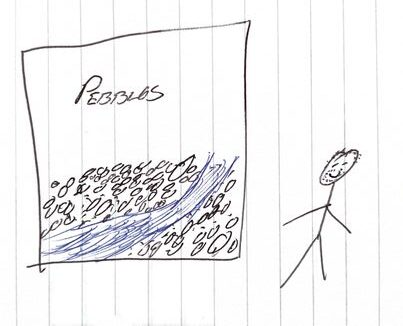Hutton Club Seminar or How to give a presentation that doesn’t put your audience to sleep

Alex suggested we go along to see the beginning of the Hutton Club seminar series this semester to critique the presentation style and learn a bit from it. I do have to be quite polite about the talk as I feel it would be bad form to try and tear down my supervisor but conveniently it was a very well-given presentation, so I should be fine. Mikael Attal was talking about sediment flux in rivers in the Himalayas and how he and Simon Mudd have been trying to figure out a way to predict sediment size in mass flows before they occur.
Presentation Style
Mikael is a very charismatic and excited speaker, he is clearly still fascinated by the work he does and enjoys it immensely. This helped draw in the audience and keep everyone’s attention as his passion for the topic was rather contagious.
Slides
Mikael’s slides towards the beginning of the talk were pretty clunky. There were lots of pictures and graphs, and though he explained them all very well, it was a bit distracting. However, he made the graphs and images appear on his slides as he discussed them. They would either appear over the previous image or show up next to it. The strength of this was that he could describe each graph in it’s own right, then compare them to each other without having to flick back and forth between slides.
He also had colourful boxes appear around the specific graph or figure he was talking about once there was a lot of material on the page. This meant that even though the slide itself was pretty cluttered it was still clear what he was referring to and which figures related to which. Though this was a good way to cope with busy slides, it was still easier to focus on the middle part of the talk where it was typically one figure to a slide.
It almost prompts a thought exercise in whether it is better to use an interesting and effective method to cope with overcrowding on a slide or simply to avoid the problem in the first place? There are strengths to both, but setting up all those transitions and boxes and overlays is a lot more time consuming than simply moving to the next slide. So it also depends on how much time you want to spend making your slides. If this was a last minute rush it would not be possible to have some of these snazzy transitions and overlays. It does tell us that he has put a lot of effort into his presentation and clearly cares about the work he has done and wants us to understand what we’re looking at.
Something else that was quite interesting was his effective use of Twitter. I’ve never seen twitter screenshots in a talk before but it was a pretty novel and engaging way to highlight the importance and social relevance of various parts of the talk, and definitely something I’m going to steal for my own work.
Questions
Mikael handled the questions he was asked very well. Whereas in some presentations you can see that clearly the speaker doesn’t know much outside of what they’ve said in the presentation, that was clearly not the case here. There was only one question that seemed to catch him off guard – and in fairness I think it’s something that each and every one of us would struggle to answer confidently, if at all. Alex made the point that the work done on landslides, and identifying areas at risk of landslides, in conjunction with the vastly increasing resolution of satellite data and DEMs, (especially with the advent of LiDAR) could in fact be used to cause harm. And he is not wrong. In fact, during his seminar Mikael mentioned that they have found what they term ‘sediment bombs’ (areas at particular risk of landslide which have the potential to mobilise massive amounts of sediment very rapidly). And he told us that this wasn’t an element they had discussed during their research.
This is something I find particularly relevant to my own work of modelling Glacial Lake Outburst Floods (GLOFs) and creating hazard maps for towns downstream of them. Obviously the purpose of all work on hazards is to allow us to try and better predict or prevent these events, to inform city planners and governments about areas where to or not to build houses or where to install defences or mitigations. But of course this work is all available in the public domain and if someone wanted to instigate these kinds of events, we’ve told them how to do it and where will be worst effected. So thanks Alex, on the one hand for an extra paragraph in my project report and on the other, the fear that I might be making the world a worse place.
Conclusion
Overall, I think Mikael gave a very effective and interesting talk. The audience was engaged throughout the entire seminar and had plenty of questions at the end, all of which Mikael fielded very well, with the sole exception of the one mentioned above. Despite my misgivings about whether animations are worth the time it takes to include them i think i will try and apply them into my next presentation, to do my own wee test i suppose. Additionally he had a very nice but subtle theme to his slides so i’ll see if i can implement that into my own work as well, and see if i can do it as well as he did.




Recent comments